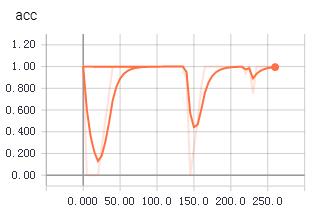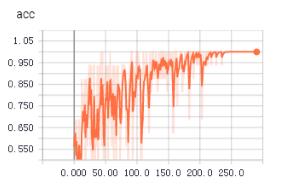tensorflowxun训练自己的数据集之从tfrecords读取数据
Posted 康小武
tags:
篇首语:本文由小常识网(cha138.com)小编为大家整理,主要介绍了tensorflowxun训练自己的数据集之从tfrecords读取数据相关的知识,希望对你有一定的参考价值。
当训练数据量较小时,采用直接读取文件的方式,当训练数据量非常大时,直接读取文件的方式太耗内存,这时应采用高效的读取方法,读取tfrecords文件,这其实是一种二进制文件。tensorflow为其内置了各种存储和读取的函数,方便调用。
不知道为啥,从tfrecords中读取数据用于训练时,收敛得更快,更平稳。上面两个图是使用tfrecords的准确率和loss值变化,下面是直接读取文件的准确率和loss值变化。




1 生成记录样本的记录文件
1 root_dir = os.getcwd() 2 3 def getTrianList(): 4 with open("train.txt","w") as f: 5 for file in os.listdir(root_dir+\'\\\\dataSet\'): 6 for picFile in os.listdir(root_dir+"\\\\dataSet\\\\"+file): 7 f.write("dataSet/"+file+"/"+picFile+" "+file+"\\n") 8 print(picFile) 9 if __name__=="__main__": 10 getTrianList()
将样本文件路径和标签统一记录到一个txt中,后面生成tfrecords文件就是通过读取这些信息。

注意文件路径和标签之间采用空格,不要使用制表符。
2 读取txt存于数组中
1 def load_file(example_list_file): 2 lines = np.genfromtxt(example_list_file,delimiter=" ",dtype=[(\'col1\', \'S120\'), (\'col2\', \'i8\')]) 3 examples = [] 4 labels = [] 5 for example,label in lines: 6 examples.append(example) 7 labels.append(label) 8 #convert to numpy array 9 return np.asarray(examples),np.asarray(labels),len(lines)
这段代码主要用来读取第1步生成的txt,将文件路径和标签存于数组中
3 读取图片
1 def extract_image(filename,height,width): 2 print(filename) 3 image = cv2.imread(filename) 4 image = cv2.resize(image,(height,width)) 5 b,g,r = cv2.split(image) 6 rgb_image = cv2.merge([r,g,b]) 7 return rgb_image
使用cv2读取图片文件
4 转化为tfrecords文件
1 def trans2tfRecord(trainFile,name,output_dir,height,width): 2 if not os.path.exists(output_dir) or os.path.isfile(output_dir): 3 os.makedirs(output_dir) 4 _examples,_labels,examples_num = load_file(train_file) 5 filename = name + \'.tfrecords\' 6 writer = tf.python_io.TFRecordWriter(filename) 7 for i,[example,label] in enumerate(zip(_examples,_labels)): 8 print("NO{}".format(i)) 9 #need to convert the example(bytes) to utf-8 10 example = example.decode("UTF-8") 11 image = extract_image(example,height,width) 12 image_raw = image.tostring() 13 example = tf.train.Example(features=tf.train.Features(feature={ 14 \'image_raw\':_bytes_feature(image_raw), 15 \'height\':_int64_feature(image.shape[0]), 16 \'width\': _int64_feature(32), 17 \'depth\': _int64_feature(32), 18 \'label\': _int64_feature(label) 19 })) 20 writer.write(example.SerializeToString()) 21 writer.close()
1 def _int64_feature(value): 2 return tf.train.Feature(int64_list=tf.train.Int64List(value=[value])) 3 4 def _bytes_feature(value): 5 return tf.train.Feature(bytes_list=tf.train.BytesList(value=[value]))
5 从tfrecords中读取训练数据
1 def read_tfRecord(file_tfRecord): 2 queue = tf.train.string_input_producer([file_tfRecord]) 3 reader = tf.TFRecordReader() 4 _,serialized_example = reader.read(queue) 5 features = tf.parse_single_example( 6 serialized_example, 7 features={ 8 \'image_raw\': tf.FixedLenFeature([], tf.string), 9 \'height\': tf.FixedLenFeature([], tf.int64), 10 \'width\':tf.FixedLenFeature([], tf.int64), 11 \'depth\': tf.FixedLenFeature([], tf.int64), 12 \'label\': tf.FixedLenFeature([], tf.int64) 13 } 14 ) 15 image = tf.decode_raw(features[\'image_raw\'],tf.uint8) 16 #height = tf.cast(features[\'height\'], tf.int64) 17 #width = tf.cast(features[\'width\'], tf.int64) 18 image = tf.reshape(image,[32,32,3]) 19 image = tf.cast(image, tf.float32) 20 image = tf.image.per_image_standardization(image) 21 label = tf.cast(features[\'label\'], tf.int64) 22 print(image,label) 23 return image,label
从tfrecords文件中读取image和label,训练的时候,直接使用tf.train.batch函数生成用于训练的batch即可。
1 image_batches,label_batches = tf.train.batch([image, label], batch_size=16, capacity=20)
其余的部分跟之前的训练步骤一样。
以上是关于tensorflowxun训练自己的数据集之从tfrecords读取数据的主要内容,如果未能解决你的问题,请参考以下文章